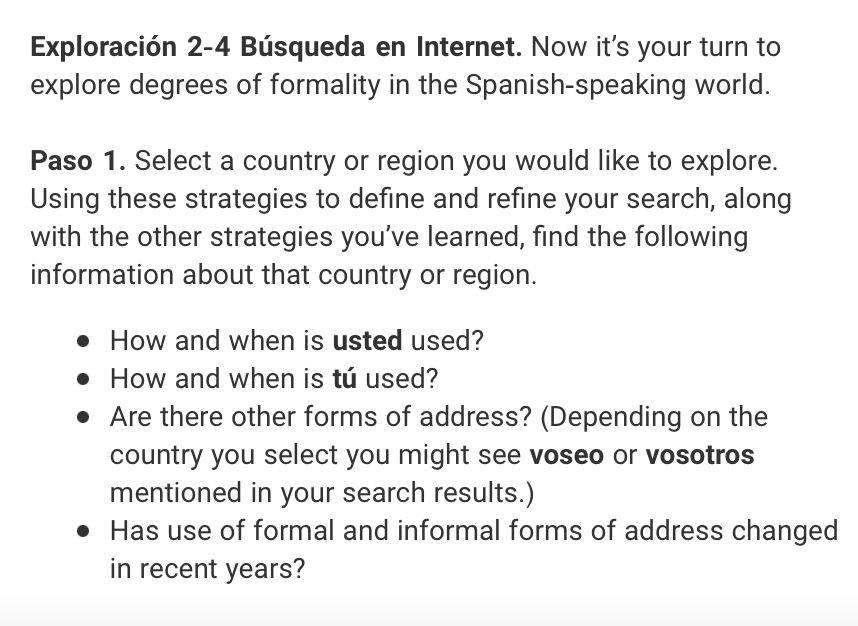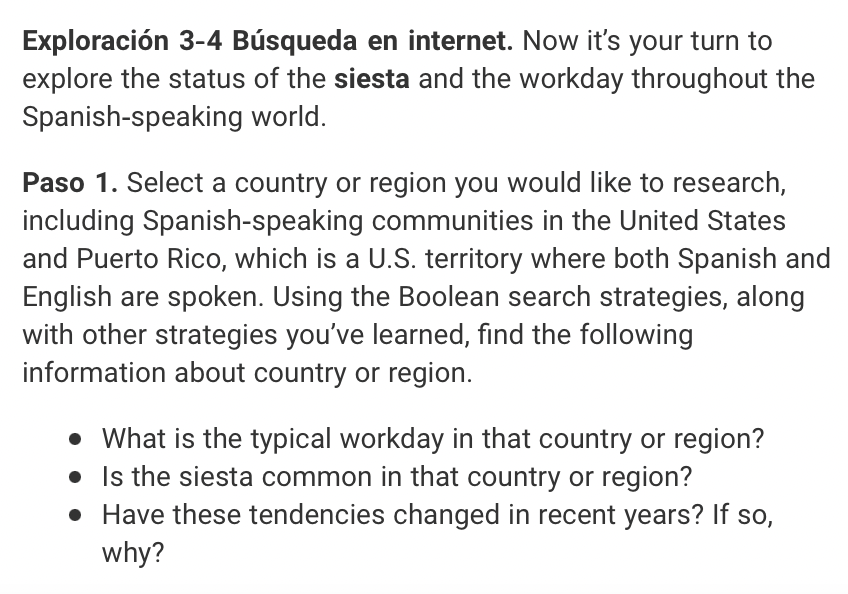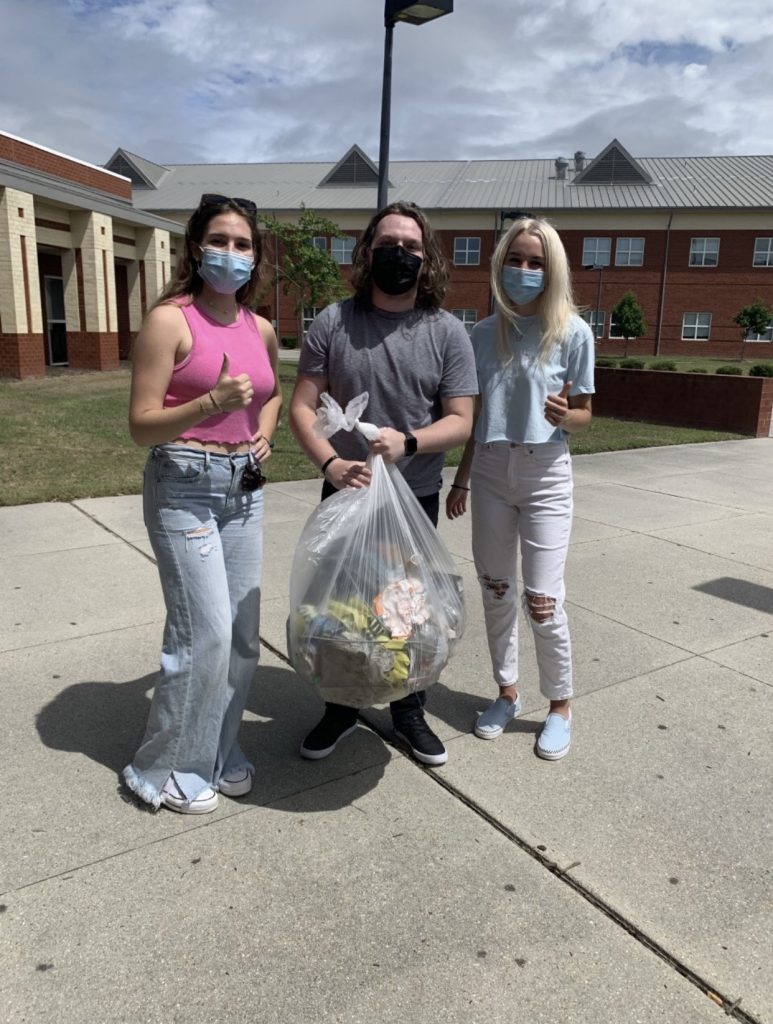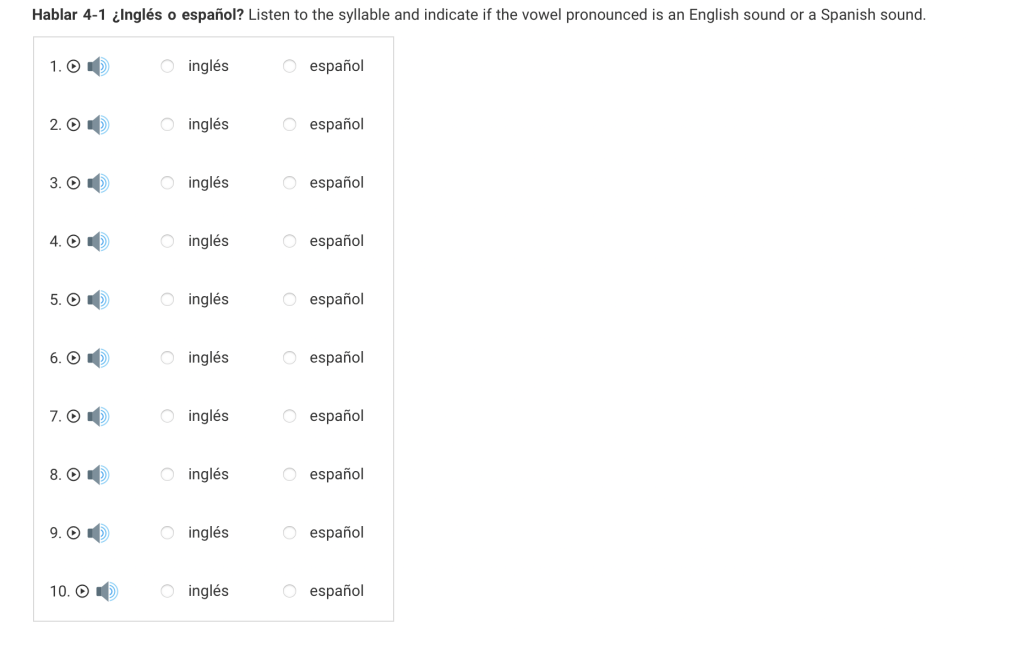Exploring Culture
Throughout this course, there were a couple of activities in Lingro Learning that required me to research the Spanish culture. Lingro Learning is a platform used in my SPAN 101 class. It allowed the class to learn the material in each module, practice the material, and complete assignments for grades. We also completed a discussion board that required us to compare greetings in Spanish-speaking countries to the ones in America.



Above, I inserted some screenshots from Lingro Learning. Each screenshot is a different activity that required me to research a topic about Spanish-speaking countries. Lingro Learning helped me better understand Hispanic culture because it had me research their countries compared to the United States. For example, one of the activities asked me to research a typical workday in Spanish-speaking countries. Another question asked me to research which social media platforms were used most in Spanish-speaking countries. These practices challenged my worldview because it made me realize that was is normal for us in this country might not be normal in other countries. It was interesting to see how my life in America differs from someone’s life in Puerto Rico. The discussion board I completed about Spanish greetings helped me work through my misconceptions I previously had. I knew some things about Spanish countries when it came to their greetings, but for the most part, it was all new information. I thought it was incredibly interesting to see how greetings in Spanish countries are different compared to America. Spanish-speaking countries have more respect in their greetings, as well as more physical touch. This course allowed me to open my eyes and learn about a culture I had barely any knowledge about.
Engaging in Communities
I think it is incredibly important to engage in your community; whether that’s your neighborhood or the entire world. Getting involved with your community allows you to have many amazing opportunities. For example, it gives you insight on what’s going on in the world around you. Getting involved with your community also allows you to meet new people, which can open doors to so much more. It is also an easy way to help others or just help your community as a whole. It is extremely important to do as much as you can to help the world around you; you never know what impact you could have.

Interpersonal Communication
Oral/audio activities were assignments we needed to complete that required us to either talk in Spanish or listen to audio’s of someone else speaking Spanish. We used Lingro Learning and discussion boards as platforms to not only practice speaking, but practice listening. This class also required us to have oral assessments with our instructor. These assessments consisted of the instructor asking us questions and us answering all in Spanish.
Out of all the communication activities, I found that discussion boards were the easiest. The questions asked in the discussion boards allowed for a lot of freedom within our answers. Discussion boards were typically in English, but it still allowed me to communicate with the other students in my class. I also found that listening activities on Lingro Learning or quizzes through Canvas was something I excelled at. Most of the activities consisted of someone saying a word in Spanish and me picking which word they said. However, some listening activities required me to listen to conversations between Spanish speakers and answer questions, which I struggled with a bit more.
The two main oral/audio activities I struggled with most were the Lingro Learning activities and the oral assessments with my instructor. The Lingro Learning activities were difficult for me because I thought that the speaker was going too fast. For a lot of the activities, I had Google Translate listen to the speaker so that I could be aware of what was actually being said. Google Translate helped me a lot, but it is not the most efficient when trying to learn. I mainly struggled with the oral assessments with my instructor. The reason I struggled with these assessments was because I did not really know which exact questions would be asked. I had some ideas as to what she would ask, but I just felt like there were so many other possibilities, so I did not know what exactly to study. If I could do these assessments differently, I would focus on the questions that seemed to be a reoccurrence throughout each module and review each question repeatedly.
Presentational Speaking
We used one main platform for presentational speaking activities, which was FlipGrid. FlipGrid is a website that allowed the students to record themselves speaking in Spanish and uploading them so everyone in the class can listen and respond.
I found myself struggling a little bit when completing the FlipGrids. The more FlipGrids we did, the more I understood what was required. As the semester went on, it was easier for me to complete the FlipGrids because I knew what to expect and how to prepare better. The required material got more difficult as the semester went on, but I tried my best to complete each oral activity confidently. The main thing that helped me prepare for these activities was writing out everything I needed to say in my video. After doing so, I was able to repeat each answer until I got it down without looking. If I could do this differently, I would definitely keep practicing until I got the pronunciation down because I seemed to struggled a lot with that.
Presentational Writing
During this course, we did not have many written presentation activities. However, some activities in Lingro Learning or on discussion boards required us to answers questions in Spanish, which created little Spanish paragraphs.
Lingro Learning had several activities which required us to type full paragraphs in Spanish. Along with Lingro Learning, similar activities occurred through discussion boards on Canvas. For example, we recently had a discussion board to describe our favorite person in Spanish. I found some of these written presentations difficult because I struggle with conjugating words while answering questions. I also found it difficult to start the sentences and include all of the little words in between. Something I did excel at was using the vocabulary from each module to help guide me through the presentations. Next time, I need to practice conjugating so that I can answer the questions from my point of view.
Interpretive Listening
This course included several activities that involved interpretive listening. These listening assignments were included in Lingro Learning activities, quizzes on Canvas, and oral assessments from the instructor.
Throughout the semester, I was quizzed on how well I could listen and interpret Spanish. These quizzes or assignments usually consisted of someone saying a word or phrase in Spanish. I would have to choose what answer I believe is correct. For the most part, these assignments were decent. I did not find myself struggling too much, unless the speaker was going too fast. Therefore, the main issue I ran into was trying to understand a fast speaker. To overcome this difficulty, I would slow down the audio if I could; if not, then I would repeatedly listen until I heard and understood every word. The main thing I learned from these listening activities was how to pronounce certain words correctly. I found it interesting to see how Spanish words were written compared to how they were pronounced. I found myself getting more challenged as the topics slowly progressed; however, I just continued to listen slowly and thoroughly.

Interpretive Reading
In English, give a very brief 2-3 line description of interpretive communication activities you read in and out of class this semester, such as articles, stories, websites like the Language Learning Center, etc. that you completed for or related to your Spanish learning. Include a copy of one of these activities; remember to cite it. (See Modes of Communication link for description and examples).
I found that most of the interpretive communication activities took place through discussion boards on Canvas. One of the discussion board activities asked us to read an article about universities in Spanish-speaking countries and compare them to universities in America.
Study in Spain: A guide for expat students. Expatica Spain. (2023, March 6). Retrieved April 18, 2023, from https://www.expatica.com/es/education/higher-education/study-in-spain-101452/
I added the link to the same article we used for the discussion board in class. For this discussion board we had to discuss the similarities and differences we noticed in Spanish-speaking universities compared to American universities. I enjoyed this assignment because nothing was difficult nor challenging for me. It allowed me to research a university in Spain and compare it to the one I go to in America. I found activities like this the most interesting because I was able to get a better understanding about Spanish-speaking countries. For example, I found that Spanish-speaking universities focus more on academics, while American universities focus on academics, athletics, and clubs. I grew from each of these research assignments because each assignment allowed me to acquire more information about Spanish-speaking countries I did not have before.